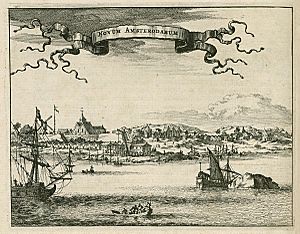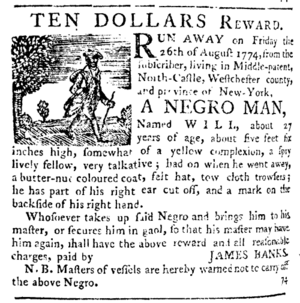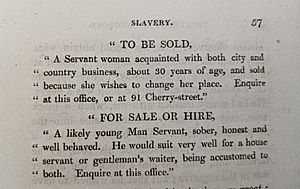History of slavery in New York (state) facts for kids
The enslavement of African people in the United States began in New York as part of the Dutch slave trade. In 1626, the Dutch West India Company brought eleven enslaved Africans to New Amsterdam. The first auction for enslaved people in New Amsterdam happened in 1655. By 1703, more than 42% of New York City homes had enslaved people. This was the second-highest percentage of any city in the colonies, after Charleston, South Carolina. Enslaved people often worked as house servants and laborers. Others were skilled workers or worked in shipping and other city trades. Enslaved people also worked on farms on Long Island and in the Hudson Valley and Mohawk Valley region.
During the American Revolutionary War, British troops took over New York City in 1776. The British promised freedom to enslaved people who left their rebel masters. Thousands moved to the city for safety with the British. By 1780, about 10,000 black people lived in New York. Many were enslaved people who had escaped from their enslavers in both Northern and Southern colonies. After the war, the British helped about 3,000 enslaved people leave New York. Most of them went to live as free people in Nova Scotia, where they are known as Black Loyalists.
New York was one of the last Northern states to officially end slavery. The New York Manumission Society was started in 1785 to work for the end of slavery and to help free black people. In 1799, the state passed a law for gradual abolition. This law did not free any enslaved person right away. Instead, children born to enslaved mothers after that date had to work for their mother's enslaver as indentured servants until they were 28 (for men) or 25 (for women). The very last enslaved people were freed from this rule on July 4, 1827. African Americans celebrated with a big parade.
Upstate New York, unlike New York City, was a leader in the anti-slavery movement. The first meeting of the New York State Anti-Slavery Society started in Utica. However, because of local opposition, the meeting had to move to the home of Gerrit Smith in Peterboro. The Oneida Institute, near Utica, was a center for abolitionism. It accepted both black and white male students equally. New-York Central College, near Cortland, was another abolitionist school. It was the first college to have black professors teaching white students.
Contents
- Dutch Rule and the Start of Slavery in New York
- English Rule and the Growth of Slavery
- The American Revolution and Freedom
- The Gradual End of Slavery
- Voting Rights for Black Men
- Freedom's Journal and Black Voices
- Illegal Slave Trade in New York City
- New York City and Brooklyn During the Civil War Era
- African Burial Ground Discovery
Dutch Rule and the Start of Slavery in New York
First Enslaved People Arrive in New Amsterdam
In 1613, Juan (Jan) Rodriguez from Santo Domingo became the first non-Native American person to settle in what was then called New Amsterdam. He was a free man of Portuguese and West African background.
Systematic slavery began in 1626. That year, eleven captive Africans arrived on a Dutch West India Company ship in the New Amsterdam harbor. Historian Ira Berlin called them Atlantic Creoles. These were people with both European and African backgrounds who often spoke many languages. Some gained their European heritage in Africa when European traders had children with African women. Others were African crew members on ships or came from ports in the Americas. Their first names, like Paul, Simon, and John, sometimes showed European heritage. Their last names, like Portuguese, d'Congo, or d'Angola, showed where they came from. People from the Congo or Angola were known for their mechanical skills. Six enslaved people had names that connected them to New Amsterdam, such as Manuel Gerritsen. This name was likely given to him after arriving in New Amsterdam to tell him apart from others with the same first name. Enslaved men worked as laborers, building forts and roads, and doing other hard work.
According to a rule called partus sequitur ventrem, which was adopted from southern colonies, children born to enslaved women were also considered enslaved. This was true no matter what the father's background or status was.
In February 1644, the eleven enslaved people asked Willem Kieft, the colony's director general, for their freedom. At this time, there were fights with Native American people. The Dutch wanted black people to help protect their settlements and did not want enslaved people to join the Native Americans. These eleven enslaved people were given partial freedom. This meant they could buy land and a home and earn wages from their enslaver. Later, they received full freedom. However, their children remained enslaved. By 1664, the original eleven enslaved people, along with other enslaved people who had gained half-freedom, became landowners. A total of at least 30 black landowners lived on Manhattan near the Fresh Water Pond.
The Dutch Slave Trade in New York
For more than twenty years after the first shipment, the Dutch West India Company was the main importer of enslaved people from Africa. Many enslaved people were brought directly from the company's trading posts in Angola to New Netherland.
The colony needed workers, so it relied on enslaved Africans. The Dutch West India Company allowed people in New Netherland to trade enslaved people from Angola for "seasoned" African enslaved people from the Dutch West Indies, especially Curaçao. These "seasoned" enslaved people had already survived the harsh conditions of slavery in the Caribbean and often sold for more. People also bought enslaved people captured from Spanish slave ships by privateers. For example, a French privateer ship, La Garce, arrived in New Amsterdam in 1642 with "Spanish Negroes" captured from a Spanish ship. Even though they said they were free and not African, the Dutch sold them as enslaved people because of their skin color.
In the North, famous people like Benjamin Franklin, William Penn, and John Hancock owned enslaved people. In New Amsterdam, William Henry Seward grew up in a family that owned enslaved people. Later, he became Abraham Lincoln's Secretary of State during the Civil War and was against slavery.
Unlike enslaved people in some other colonies, enslaved people in New Amsterdam could sue other people, whether white or black. Early cases included lawsuits for lost wages and for damages when an enslaved person's dog was hurt by a white man's dog. Enslaved people could also be sued themselves.
Partial and Full Freedom for Enslaved People
By 1644, some enslaved people in New Amsterdam had earned partial freedom, also called half-freedom. This allowed them to earn wages. Under Roman-Dutch law, they had other rights in business. It was also common for them to marry working-class white people. Land records show that the Land of the Blacks was located just north of New Amsterdam. As the English began to take over New Amsterdam in 1664, the Dutch freed about 40 men and women who had half-slave status. This was to make sure the English would not keep them enslaved. The new free people had their original land grants officially confirmed as their own.
English Rule and the Growth of Slavery
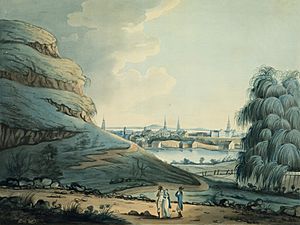
In 1664, the English took control of New Amsterdam and the colony. They continued to bring in enslaved people to do the necessary work. Enslaved Africans performed many different skilled and unskilled jobs. Most of these jobs were in the growing port city and the farms around it. In 1703, more than 42% of homes in New York City owned enslaved people. This was a higher percentage than in cities like Boston and Philadelphia, and second only to Charleston in the South.
In 1708, the New York Colonial Assembly passed a law called "Act for Preventing the Conspiracy of Slaves." This law said that any enslaved person who murdered or tried to murder their enslaver would be sentenced to death. This law was one of the first of its kind in Colonial America. It was partly a reaction to the murder of William Hallet III and his family in Newtown (Queens).
In 1711, a formal slave market was set up at the end of Wall Street on the East River. It operated until 1762.
In 1730, the New York General Assembly passed another law, the last of a series of New York slave codes. It stated: "Because the number of enslaved people in the cities of New York and Albany, and in the counties, towns, and manors of this colony, increases daily, and they have often been guilty of running away together and other bad and dangerous actions, it is unlawful for more than three enslaved people to meet together at any time, unless they are doing work for their masters' or mistresses' profit, and with their masters' or mistresses' permission. If they break this rule, they will be whipped on their bare back, up to forty lashes for each offense, as decided by any justice of the peace."
Manors and towns could hire a person to whip enslaved people, paying no more than three shillings per person. Black people were given the lowest status jobs, the ones the Dutch did not want to do, like carrying out physical punishments and executions.
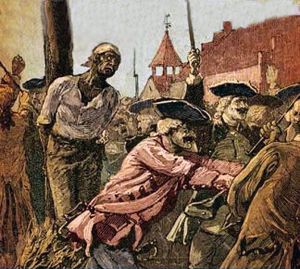
Like in other places where slavery existed, the city often feared slave revolts. Events were sometimes misunderstood in these conditions. In what was called the New York Conspiracy of 1741, city officials believed a revolt had begun. Over several weeks, they arrested more than 150 enslaved people and 20 white men. They put many on trial and executed several, believing they had planned a revolt. Historian Jill Lepore believes white people unfairly accused and executed many black people during this event.
In 1753, the Assembly decided that "for every Negro, Mulatto, or other enslaved person, four years old and older, brought directly from Africa, five ounces of Seville Pillar or Mexico plate [silver], or forty shillings in bills of credit made current in this colony" should be paid.
The American Revolution and Freedom
African Americans fought on both sides during the American Revolution. Many enslaved people chose to fight for the British. General Guy Carleton promised them freedom if they served. After the British took over New York City in 1776, enslaved people escaped to their lines to gain freedom. The black population in New York grew to 10,000 by 1780. The city became a major center for free black people in North America. Among those who escaped were Deborah Squash and her husband Harvey, who were enslaved by George Washington. They fled his plantation in Virginia and found freedom in New York.
In 1781, the state of New York offered enslavers money if they allowed their enslaved people to join the military. The enslaved people were promised freedom at the end of the war. In 1783, black men made up one-quarter of the rebel militia in White Plains. These soldiers were to march to Yorktown, Virginia for the final battles.
The Treaty of Paris (1783) stated that all American property, including enslaved people, should be left in place. However, General Guy Carleton kept his promise to the freed people. When the British left New York, they transported 3,000 Black Loyalists on ships to Nova Scotia (now Maritime Canada). Their names were recorded in the Book of Negroes. With British help, a large group of these Black Britons left Nova Scotia in 1792 to create their own colony in Sierra Leone.
The Gradual End of Slavery
In 1781, the state legislature voted to free enslaved people who had fought for three years with the rebels or were officially released during the Revolution. The New York Manumission Society was founded in 1785. It worked to stop the international slave trade and achieve abolition. The society started the African Free School in New York City. This was the first official school for black people in North America, serving both free and enslaved children. The school grew to seven locations, and some of its students went on to higher education and successful careers. One such student was James McCune Smith. He earned his medical degree with honors at the University of Glasgow after being denied entry to two New York colleges. He returned to practice medicine in New York and published many articles.
By 1790, one out of every three black people in New York state was free. Especially in areas with many black residents, like New York City, they formed their own independent communities. They created their own churches, helpful organizations, and businesses that served their interests.
Even though there was a movement to end slavery, the legislature took steps to define indentured servitude for black people in a way that changed how slavery worked in the state. Slavery was important for the economy, both in New York City and in farming areas like Brooklyn. In 1799, the legislature passed the Act for the Gradual Abolition of Slavery. This law did not free any enslaved person who was alive at the time. It said that children born to enslaved parents after July 4, 1799, would be legally free. However, these children had to serve a long period of indentured servitude: until age 28 for males and 25 for females. Enslaved people born before that date were called indentured servants and could not be sold, but they still had to work without pay. From 1800 to 1827, white and black abolitionists worked to end slavery and gain full citizenship in New York. During this time, there was also a rise in white supremacy, which went against the growing anti-slavery efforts. Peter Williams Jr., an important black abolitionist and minister, encouraged other black people to "strictly obey and respect the laws of the land" to improve their chances of freedom and a better life.
African Americans' participation as soldiers in defending the state during the War of 1812 helped gain public support for their full rights to freedom. In 1817, the state freed all enslaved people born before July 4, 1799 (the date of the gradual abolition law), with this freedom taking effect in 1827. The law continued the indenture of children born to enslaved mothers until their twenties, as mentioned earlier. Because of these gradual abolition laws, some children were still bound in apprenticeships even when their parents were free. This encouraged more African-American anti-slavery activists.
In his book Sketches of America (1818), British author Henry Bradshaw Fearon visited the United States to gather information for Britons thinking about moving there. He described the situation in New York City in August 1817:
"New York is called a 'free state:' it may be so in theory, or compared to its southern neighbors; but if, in England, we saw in the Times newspaper such advertisements as the following [see image], we would conclude that freedom from slavery existed only in words."
On July 5, 1827, the African-American community celebrated final emancipation in the state with a parade through New York City. They chose a special Fifth of July celebration instead of July 4. This was because the national holiday was not seen as being for black people, as Frederick Douglass later explained in his famous What to the Slave Is the Fourth of July? speech on July 5, 1852.
Voting Rights for Black Men
New York residents were less willing to give black people equal voting rights. The constitution of 1777 limited voting to free men who owned a certain amount of real estate. This property rule prevented poor men, both black and white, from voting. The reformed Constitution of 1821 removed the property requirement for white men. However, it set a very high requirement of $250 (about the price of a small house) for black men. In the 1826 election, only 16 black men voted in New York City. In 1846, a public vote to remove this property requirement was strongly defeated. Even as late as 1869, most of the state's voters chose to keep property requirements that kept many black men from voting in New York. African-American men did not get equal voting rights in New York until the Fifteenth Amendment to the United States Constitution was approved in 1870.
Freedom's Journal and Black Voices
Starting on March 16, 1827, John Brown Russwurm published Freedom's Journal. This newspaper was written by and for African Americans. Samuel Cornish and John Russwurm were the editors. They used the journal to reach out to African Americans across the nation. The powerful words published in the journal quickly spread positive influence to African Americans who could help build a new community. The start of an African-American journal was a very important step in New York. It showed that black people could get an education and be part of a literate society.
White newspapers published a fictional "Bobalition" print series. This was made to make fun of black people, using how an uneducated black person might pronounce "abolition."
Illegal Slave Trade in New York City
Beginning in the early 1850s, New York City became a main center for the illegal Atlantic slave trade. The U.S. Congress had banned this trade in 1807. The main slave traders arrived in Manhattan during this time from Brazil and Africa. They became known as the Portuguese Company. Two of the key traffickers were Manoel Basilio da Cunha Reis and Jose Maia Ferreira. They pretended to be legal merchants but actually bought ships. They sent these ships to the African coast, usually the Congo River region. Most of these ships were headed for Cuba. In total, over 400 illegal slave ships left the United States during this period. Most of them sailed from New York, though others left from New Orleans, Boston, and other smaller ports. This trade was possible because of American captains and sailors, corrupt U.S. officials in New York, and the ruling Democratic Party, which did not try hard to stop the trade.
New York City and Brooklyn During the Civil War Era
New York City Mayor Fernando Wood strongly supported slavery. He was a leader of the peace Democrats, who were against the 13th Amendment that ended slavery. Just before the Civil War, he seriously suggested to the City Council that the city should leave the Union. He proposed forming the Free City of Tri-Insula (insula means "island" in Latin), which would include Manhattan, Staten Island, and Long Island (except for pro-Union Brooklyn). The City Council approved the plan, but they changed their minds three months later, after the Battle of Fort Sumter.
In contrast, Brooklyn was like a "sanctuary city" even before the term existed. It had one of the largest and most politically active Black communities in the United States. Henry Ward Beecher, the brother of Harriet Beecher Stowe, was a pastor at the Plymouth Church in Brooklyn Heights. He was one of the country's most active abolitionists.
African Burial Ground Discovery
In 1991, a construction project needed an archaeological and cultural study at 290 Broadway in Lower Manhattan. This was required by the National Historic Preservation Act of 1966 before building could start. During the digging and study, human remains were found. They were in a former six-acre burial ground for African Americans that was used from the mid-1630s to 1795. It is believed that there are more than 15,000 skeletal remains of colonial New York's free and enslaved black people. It is the country's largest and earliest burial ground for African Americans.
This discovery showed how important slavery and African Americans were to New York's and the nation's history and economy. The African Burial Ground has been named a National Historic Landmark and a National Monument because of its importance. A memorial and a center to explain its history have been created. They honor those buried there and explore the many contributions of African Americans and their descendants to New York and the nation.


